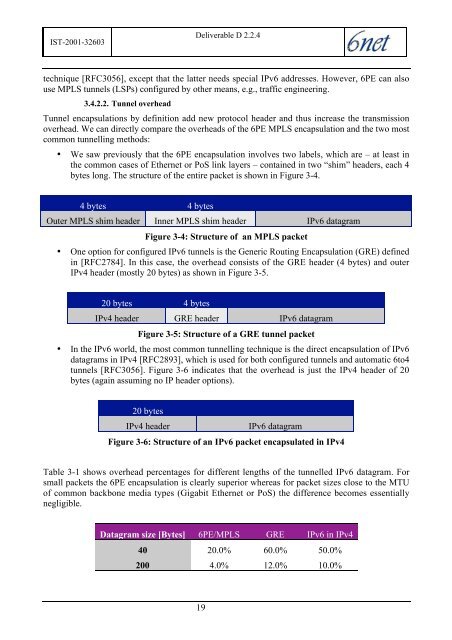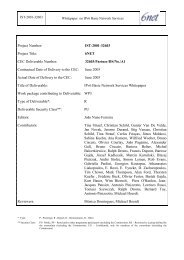D2.2.4: Final IPv4 to IPv6 Transition Cookbook for ... - 6NET
D2.2.4: Final IPv4 to IPv6 Transition Cookbook for ... - 6NET
D2.2.4: Final IPv4 to IPv6 Transition Cookbook for ... - 6NET
You also want an ePaper? Increase the reach of your titles
YUMPU automatically turns print PDFs into web optimized ePapers that Google loves.
IST-2001-32603Deliverable D 2.2.4technique [RFC3056], except that the latter needs special <strong>IPv6</strong> addresses. However, 6PE can alsouse MPLS tunnels (LSPs) configured by other means, e.g., traffic engineering.3.4.2.2. Tunnel overheadTunnel encapsulations by definition add new pro<strong>to</strong>col header and thus increase the transmissionoverhead. We can directly compare the overheads of the 6PE MPLS encapsulation and the two mostcommon tunnelling methods:• We saw previously that the 6PE encapsulation involves two labels, which are – at least inthe common cases of Ethernet or PoS link layers – contained in two “shim” headers, each 4bytes long. The structure of the entire packet is shown in Figure 3-4.4 bytes 4 bytesOuter MPLS shim header Inner MPLS shim header <strong>IPv6</strong> datagramFigure 3-4: Structure of an MPLS packet• One option <strong>for</strong> configured <strong>IPv6</strong> tunnels is the Generic Routing Encapsulation (GRE) definedin [RFC2784]. In this case, the overhead consists of the GRE header (4 bytes) and outer<strong>IPv4</strong> header (mostly 20 bytes) as shown in Figure 3-5.20 bytes 4 bytes<strong>IPv4</strong> header GRE header <strong>IPv6</strong> datagramFigure 3-5: Structure of a GRE tunnel packet• In the <strong>IPv6</strong> world, the most common tunnelling technique is the direct encapsulation of <strong>IPv6</strong>datagrams in <strong>IPv4</strong> [RFC2893], which is used <strong>for</strong> both configured tunnels and au<strong>to</strong>matic 6<strong>to</strong>4tunnels [RFC3056]. Figure 3-6 indicates that the overhead is just the <strong>IPv4</strong> header of 20bytes (again assuming no IP header options).20 bytes<strong>IPv4</strong> header<strong>IPv6</strong> datagramFigure 3-6: Structure of an <strong>IPv6</strong> packet encapsulated in <strong>IPv4</strong>Table 3-1 shows overhead percentages <strong>for</strong> different lengths of the tunnelled <strong>IPv6</strong> datagram. Forsmall packets the 6PE encapsulation is clearly superior whereas <strong>for</strong> packet sizes close <strong>to</strong> the MTUof common backbone media types (Gigabit Ethernet or PoS) the difference becomes essentiallynegligible.Datagram size [Bytes] 6PE/MPLS GRE <strong>IPv6</strong> in <strong>IPv4</strong>40 20.0% 60.0% 50.0%200 4.0% 12.0% 10.0%19






